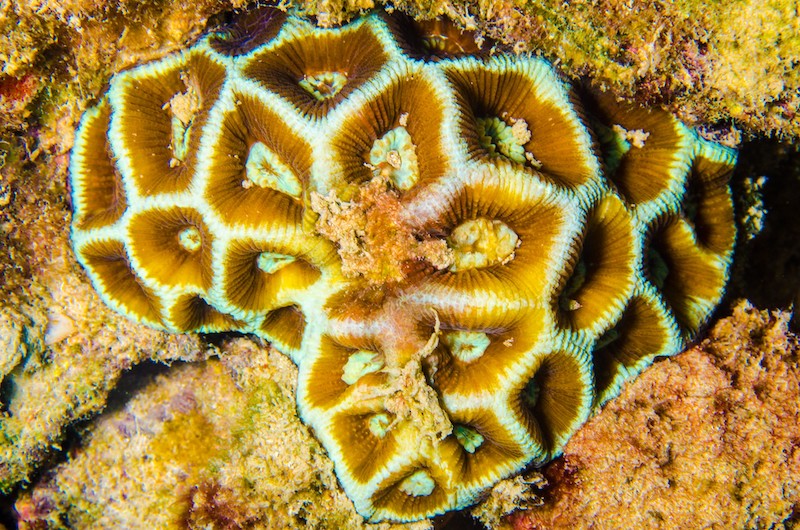This article is a guest post by long term coral-taxonomy Liason Joseph Rowlett. His Indo-Pacific corals book is one of the best and newest references to learn more about coral identification.
Coelastrea had a troubled entrance into this world. The genus dates to an 1866 paper by the illustrious Addison Emery Verrill, in which he briefly describes C. tenuis based on a single specimen collected from the “Sandwich Islands?”. These islands are better known to us today as Hawaii, but, alas, there is no coral in this region resembling Verrill’s specimen; in fact, just a single merulinid occurs there, the decidedly different Cyphastrea ocellina. So, whither the tenuis?
Owing to the confusion surrounding this name, Coelastrea (pronounced seal-ASS-tree-uh) was largely ignored for much of its existence, more often than not being regarded as a synonym of Goniastrea—both genera possess lobes on the inner margin of the septa, forming a “crown” encircling the columella, a trait that separates these from similar merulinids, such as Favites and Platygyra.
But this changed following a 2014 revision of the merulinids, wherein specimens of Goniastrea aspera and G. palauensis were shown to be genetically closer to Dipsastraea (a genus comprising the Indo-Pacific species formerly in Favia). Comparison of the type specimens of C. tenuis and G. aspera revealed that the two likely represented the same species, and thus Coelastrea was resurrected from the dead, taxonomically speaking, though it remains difficult to diagnose in terms of morphology.
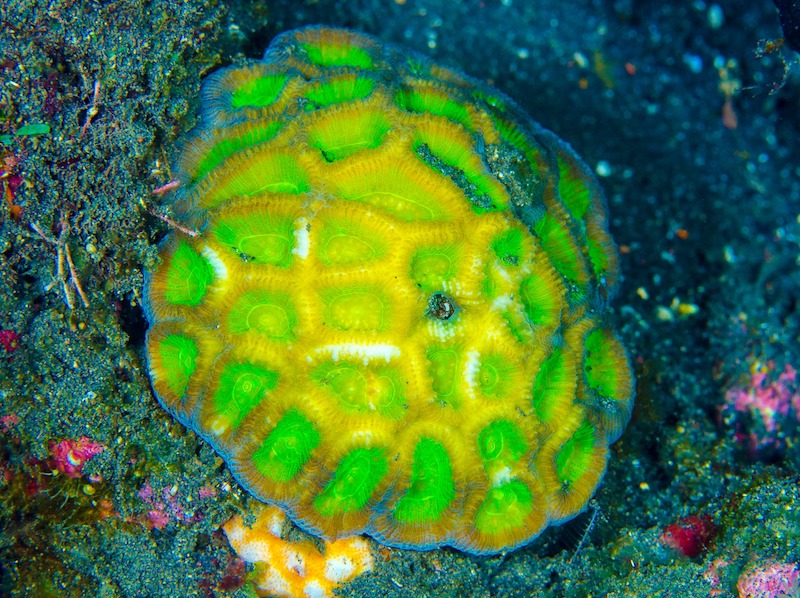
Likewise, there is considerable uncertainty regarding how diverse this group is. If we were to assume that C. tenuis and C. aspera are truly one and the same, then it would seem there are only two members. C. aspera has been recognized as widespread in the Andaman-Pacific region (though it has also been questionably reported from the Western Indian Ocean), and it is by far the more commonly reported species, often occurring in abundance on intertidal reef flats.
The other species, Coelastrea palauensis, is described from Palau and was originally classified within Favia, due to the type specimen having weakly separated corallite walls (i.e. subcerioid). But since this species more often than not has fused corallite walls (i.e. cerioid), it was later shuffled into Favites . . . and since there is also a prominent crown of septal lobes surrounding the columella, it was ultimately reclassified as a Goniastrea, before finally settling into its current home in Coelastrea. Aquarists will be familiar with this coral as the ‘Prism Favia’ (or, rather, one of the Prism Favias, as this trade name is applied haphazardly to a variety of multi-colored merulinids).
The main morphological distinction with these species is size: C. aspera has corallites that average 4–8 mm in diameter, far smaller than in C. palauensis, whose corallites can reach upwards of 2 cm. Colonies of C. palauensis are also much smaller, rarely with more than a few dozen polyps, whereas C. aspera forms pillowy colonies with hundreds of polyps. Coloration may also diagnose these to some extent, as the ‘Prism Favia’ tends to have contrastingly colored oral discs and corallite walls, while C. aspera is most often brown or mottled brown.
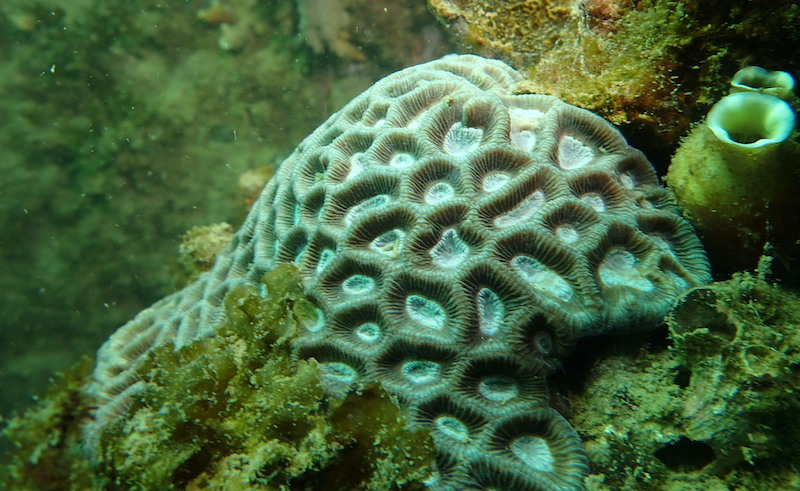
But of course things are not so simple, dear reader. Reproductive differences have been noted in the population of C. aspera from Japan, and this was recently investigated in a study by Mitsuki et al. It has been shown that some colonies emit eggs and sperm separately, while other colonies release bundles of egg and sperm together, with these two groups spawning at different times. Lo and behold, genetic data confirms that these are indeed distinct species, occurring in sympatry throughout much of the West Pacific.
Morphologically, they are nearly indistinguishable, save for some very minor differences in the septal spines. Examination of the type specimens of C. aspera, C. tenuis, and several other purported synonyms (equisepta, mantonae, spectabilis, incrustans), led to the recognition of the long-forgotten C. incrustans as a valid species for the bundled-gamete colonies.
The Mitsuki study was exhaustive in their inquiry, utilizing breeding studies to confirm that cross-fertilization of these species is rarely successful. Their distributions are similar, buy slightly different, with C. aspera having a more limited range, ending abruptly at the Amami-Oshima Islands (thus not extending into the cooler reefs of mainland Japan), whereas C. incrustans occurs as far north as Wakayama, and also into the Andaman Sea, where C. aspera is apparently absent.
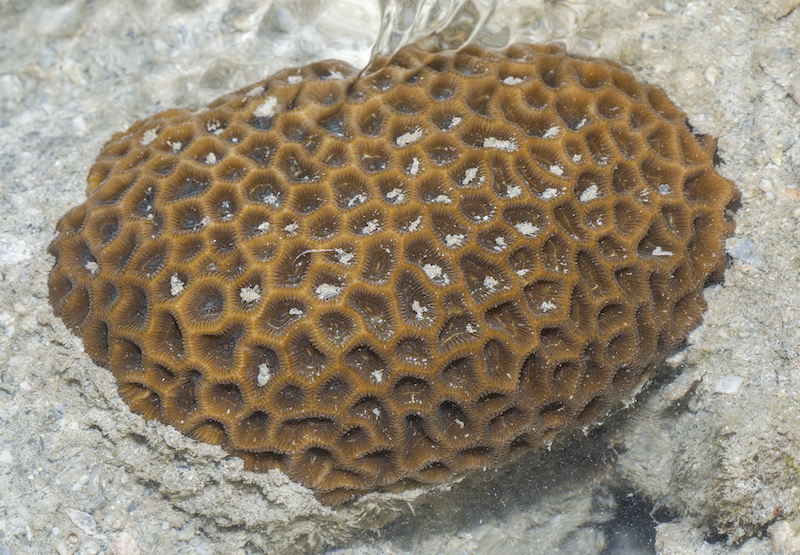
Our old friend Addison Emery Verrill described Goniastrea aspera (in fact, it was published in the very same paper, on the very same page, describing the presumably conspecific C. tenuis), and he managed to create confusion with the origins of this species as well. His description quite clearly states that the type locality was Hong Kong, but the specimens themselves bear labels indicating their provenance was “Loo Choo”, thus somewhere in or around Okinawa. Nice work, Addison.
And somehow this genus gets even more confusing! There’s genetic data suggesting the presence of another nearly indistinguishable species, with specimens found in Saudi Arabia, Thailand, and Japan—the single specimen examined from Japan had green oral discs, while the Arabian material has been tentatively identified as both C. aspera and C. palauensis, suggesting some level of phenotypic plasticity.
And there’s also some concern surrounding another species described by the loathsome Addison Emery Verrill; his Fijian Prionastraea spectabilis is a poor match for anything in Coelastrea. And it’s also quite possible that the specimens genetically sequenced for the Huang et al revision were misidentified, calling into question whether C. palauensis is correctly classified—the material used in their study for C. aspera and C. palauensis all originated from Singapore, where the ‘Prism Favia’ phenotype appears to be absent. And compounding all of this uncertainty is the reticence of morphologists
like Charles Veron, who brusquely dismisses the Huang et al revision, stating that “[Coelastrea] is a synonym of Platygyra”.
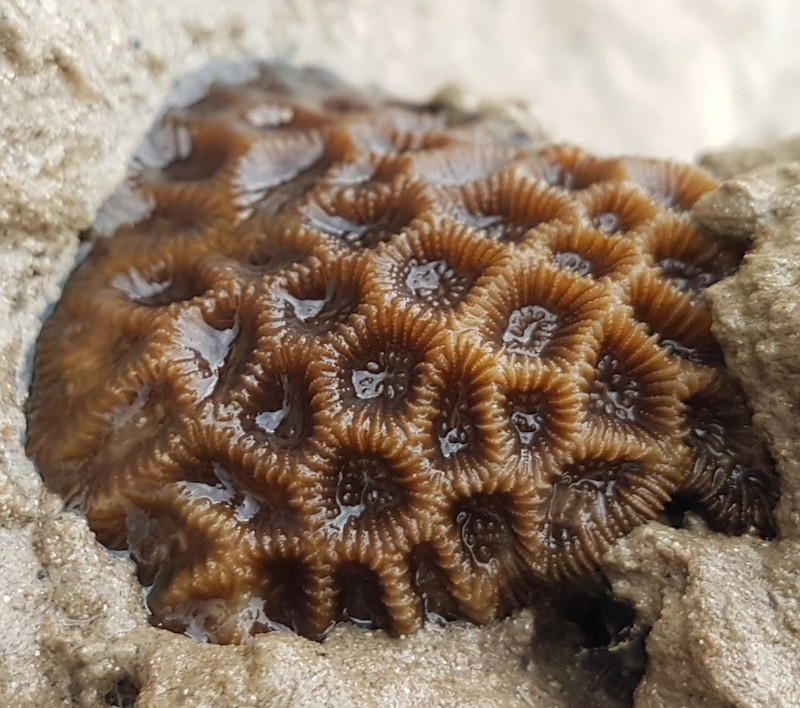
So where does this leave us? Coelastrea tenuis is probably C. aspera, which isn’t C. incrustans, or C. palauensis, which may or may not be misclassified… plus there’s probably another species that needs to be recognized, and maybe also C. spectabilis. Merulinid taxonomy is not for the faint of heart. Avoid it at all costs.


